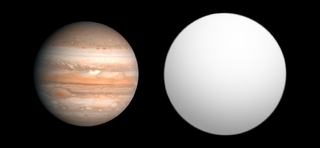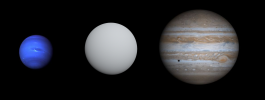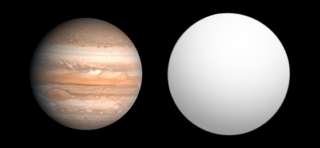
Hot Jupiters are a class of gas giant exoplanets that are inferred to be physically similar to Jupiter but that have very short orbital periods. The close proximity to their stars and high surface-atmosphere temperatures resulted in their informal name "hot Jupiters".

CoRoT-2b is the second extrasolar planet to be detected by the French-led CoRoT mission, and orbits the star CoRoT-2 at a distance of 700 light years from Earth towards the constellation Aquila. Its discovery was announced on 20 December 2007. After its discovery via the transit method, its mass was confirmed via the radial velocity method.

WASP-12b is a hot Jupiter orbiting the star WASP-12, discovered on April 1, 2008, by the SuperWASP planetary transit survey. The planet takes only a little over one Earth day to orbit its star, in contrast to about 365.25 days for the Earth to orbit the Sun. Its distance from the star is only the Earth's distance from the Sun, with an eccentricity the same as Jupiter's. Consequently, it has one of the lowest densities for exoplanets. On December 3, 2013, scientists working with the Hubble Space Telescope (HST) reported detecting water in the atmosphere of the exoplanet. In July 2014, NASA announced finding very dry atmospheres on three exoplanets orbiting sun-like stars.

CoRoT-5b is an extrasolar planet orbiting the F type star CoRoT-5. It was first reported by the CoRoT mission team in 2008 using a transit method. This planet has been confirmed by a Doppler follow-up study.

CoRoT-6b is an exoplanet that was reportedly discovered by the CoRoT mission team on February 2, 2009, orbiting the F type star CoRoT-6. It is located in the Ophiuchus constellation.
HAT-P-8 is a magnitude 10 star located 700 light-years away in Pegasus. It is a F-type star about 28% more massive than the Sun. Two red dwarf companions have been detected around HAT-P-8. The first has a spectral type of M5V and has a mass of 0.22 M☉. The second is even less massive, at 0.18 M☉, and its spectral type is M6V.
CoRoT-2 is a yellow dwarf main sequence star a little cooler than the Sun. This star is located approximately 700 light-years away in the constellation of Aquila. The apparent magnitude of this star is 12, which means it is not visible to the naked eye but can be seen with a medium-sized amateur telescope on a clear dark night.
WASP-104b is a hot Jupiter exoplanet that orbits the star WASP-104. It is considered to be one of the darkest exoplanets discovered. WASP-104b was discovered in 2014; according to a 2018 study at Keele University, the planet's dense atmosphere of potassium and sodium absorbs more than 97% of light it receives.
CoRoT-21b is a transiting exoplanet reportedly found by the CoRoT space telescope in 2011. Planetary parameters were published in 2012.

CoRoT-8b is a transiting exoplanet orbiting the K-type main sequence star CoRoT-8 1,050 light years away in the equatorial constellation Aquila. The planet was discovered in April 2010 by the CoRoT telescope.
CoRoT-10b is a transiting Hot Jupiter exoplanet found by the CoRoT space telescope in 2010.
CoRoT-11b is a transiting Hot Jupiter-sized exoplanet found by the CoRoT space telescope in 2010.

CoRoT-14b is a transiting Hot Jupiter exoplanet found by the CoRoT space telescope in 2010.
CoRoT-17b is a transiting Hot Jupiter exoplanet found by the CoRoT space telescope in 2011.
CoRoT-18b is a transiting Hot Jupiter exoplanet found by the CoRoT space telescope in 2011.
CoRoT-19b is a transiting exoplanet found by the CoRoT space telescope in 2011.
CoRoT-20b is a transiting exoplanet found by the CoRoT space telescope in 2011.
CoRoT-20c is a brown dwarf-sized exoplanet or stellar companion found by the HARPS radial-velocity search terrestrial telescope.
CoRoT-23b is a transiting Hot Jupiter exoplanet found by the CoRoT space telescope in 2011.







